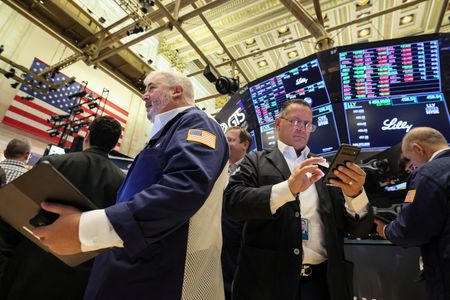By David French
(Reuters) -Wall Street finished lower on Wednesday, with the S&P 500 and Nasdaq Composite down for a second straight day as investors took profits on five months of gains a day after rating agency Fitch cut the U.S. government’s credit rating.
Fitch downgraded the United States to AA+ from AAA late on Tuesday, citing expected fiscal deterioration over the next three years as well as growing government debt. Fitch was the second major agency to cut the country’s rating. In 2011 Standard & Poor’s stripped the country of its triple-A grade.
Reaction to the news pushed major indexes lower, with the S&P 500 recording its biggest daily percentage drop since April 25. It was also the first session since May 23 in which the benchmark declined by more than 1%.
Still, several major brokerages said the downgrade was unlikely to result in a sustained drag on U.S. financial markets, noting the economy was now stronger than it was when S&P cut its rating in 2011.
July was the fifth straight month of gains for the S&P 500 and the tech-heavy Nasdaq Composite, driven by better-than-expected earnings and hopes of a soft landing for the U.S. economy.
However, with markets entering a seasonally slow August, the Fitch downgrade offered an opportunity for investors to take a breather.
“Sometimes it’s healthy to have this digestion in the market, as it brings down valuations a bit and it allows for dip-buying,” said Quincy Krosby, chief global strategist for LPL Financial in Charlotte, North Carolina.
Rate-sensitive megacap stocks, including Tesla, Nvidia, Meta Platforms and Apple, tumbled, as the yield on U.S. 10-year Treasury notes rose to its highest in nearly nine months. [US/]
Tech stocks get premium valuations because investors expect profit growth, and many fear high interest rates could slow the economy and dent that growth. Higher rates can make interest-bearing bonds an attractive alternative to stocks for some risk-averse investors, and projected company cash flows are worth less in current dollars when interest rates rise.
The technology index, dropping 2.6%, was also the worst performer of the 11 major S&P sectors, with nine in total ending the day lower.
Yields being above 4% is “not what the market wants to see”, according to LPL’s Krosby, who also predicted investors will soon look beyond Fitch’s downgrade and turn their focus to big tech company earnings due after the close on Thursday.
“The market is now going to focus on Amazon.com Inc and Apple tomorrow afternoon, and then on the payroll report on Friday, and we’ll say goodbye to Fitch,” Krosby said.
The Dow Jones Industrial Average fell 348.16 points, or 0.98%, to 35,282.52, the S&P 500 lost 63.34 points, or 1.38%, to 4,513.39 and the Nasdaq Composite dropped 310.47 points, or 2.17%, to 13,973.45.
Meanwhile, the ADP National Employment report showed private payrolls increased more than expected in July, pointing to continued labor market resilience that could shield the economy from a recession.
Despite lingering fears of a recession, corporate America has continued to perform well. With around two-thirds of the S&P 500 having already reported, 79.9% have posted earnings above analysts’ expectations, per Refinitiv I/B/E/S.
This puts the quarter on track for the highest earnings beat rate since the third quarter of 2021, per the data provider.
On the earnings front, CVS Health Corp gained 3.3% after beating Wall Street estimates for quarterly profit, and Emerson climbed 3.8% after the industrial software firm raised its annual profit outlook.
Meanwhile, Advanced Micro Devices slipped 7% over concerns its targets for an artificial intelligence (AI) ramp-up may be too ambitious. The worries overshadowed the chip designer forecasting an upbeat finish to the year.
Volume on U.S. exchanges was 11.88 billion shares, compared with the 10.79 billion average for the full session over the last 20 trading days.
The S&P 500 posted 12 new 52-week highs and five new lows; the Nasdaq Composite recorded 49 new highs and 111 new lows.
(Reporting by Johann M Cherian and Bansari Mayur Kamdar in Bengaluru and David French in New York; additional reporting by Lewis Krauskopf; Editing by Saumyadeb Chakrabarty, Vinay Dwivedi and David Gregorio)



